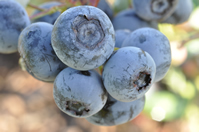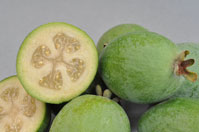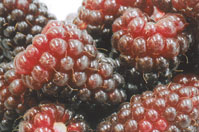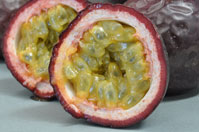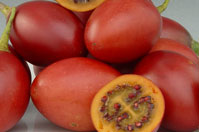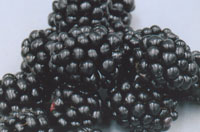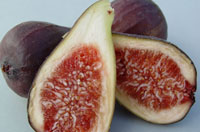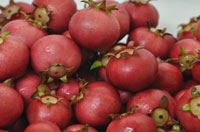
Blueberry |
Vaccinium spp. |

|
Key Points
- Sought after fruit with proven health benefits.
- Relatively easy to grow crop with few pest and disease problems.
- Suitable soil conditions are the most critical factors for successful commercial production.
- Varieties to suit all areas of N.Z.
- Wide range of markets, fresh, frozen, processed and export.
Climate
Temperature
When dormant, established blueberries can tolerate temperatures as low as -5°C. Gradual seasonal changes that promote natural hardening-off suit them best rather than sudden, extreme variations. They enjoy warm spring and summer temperatures so long as soil moisture is maintained at suitable levels.
Frost Tolerance
Winter frosts are usually no problem to established plants but heavy, spring frosts can damage flowers and fruit growth. Early autumn frosts may damage the fruit of late-cropping varieties.
Chill Hours
Temperatures above 1 deg;C and below 7 deg;C are required to provide winter chilling. Southern Highbush varieties include relatively low chill (3-500 hours), northern highbush require high winter chilling (1000 hours). Rabbiteye varieties require a moderate amount of chilling (400-700 hours).
NZ climate charts
You can read more about NZ's Cold Hardiness and Climate Zone here
Wind/Shelter
In most areas shelter is not a primary factor in successful blueberry production. It can infact be detrimental if it shades the plants or if it forms barriers that prevent air drainage and create frost-pockets.
Sunshine Hours
Blueberries need plenty of sunlight to help to develop the maximum number of flower buds.
Rainfall
Having consistently optimum soil-moisture levels throughout the growing season is crucial to achieve maximum growth and yields. Drought and flood are both detrimental to this crop so supplementary irrigation will be needed in most districts of N.Z and extra drainage measures may be required in high-rainfall areas.
Soil Requirements
Soil Type
Blueberries have very specific soil requirements. They have a shallow fibrous root system and will only thrive on moist, free draining acid soils with a high proportion of organic matter.
Well drained peat soils are ideal, but mineral soils such as sandy or silt loams are also suitable, provided peat moss or mulch is added during planting and on a regular basis afterwards. Heavy clay soils which crack in summer and become waterlogged in winter are generally not suitable for blueberries unless heavily amended with organic matter and sand.Drainage
The shallow, fibrous root system is particularly sensitive to extreme fluctuations in soil-moisture levels. Water-logged soil encourages the root-rots and diseases to which blueberries are especially vulnerable so efficient drainage is a must.
pH & Soil Testing
Before planting a soil test should be completed. Soil pH is most critical, and should lie between 4.0 and 5.2. Suggested soil test levels for the macro-elements are P, 15-25; K, 6-10: Mg, 10-12; and Ca <8.
Spacing
Planting patterns differ for Highbush and rabbiteye, largely reflecting plant growth habit and vigour.
Highbush should be spaced up to 1.2 m apart while rabbiteyes up to 2m apart within rows as they are more vigorous. Distances between rows are normally 2 to 3.5m apart depending on variety and equipment to be used. Cross pollination in blueberry is recommended and this is achievable by planting a mix of varieties.Crop Establishment
Selecting Varieties
Blueberries are classified into three major commercial types according to their stature: the Rabbiteye blueberry, Vaccinium virgatum is the tallest; the Highbush blueberry, V. corymbosum, is intermediate size and the most common, it includes southern highbush and northern highbush; and Lowbush blueberry, V, angustifolium, the smallest in size. Blueberry types differ also by way of their winter chilling requirement, fruiting season, deciduous or evergreen habit; thus it is important for growers to select species that are suited to their particular climate.
In New Zealand most blueberry production is based on Highbush and Rabbiteye varieties. Highbush blueberry varieties include southern highbush which require a low to moderate chill (below 700 hours) amount of winter chilling, and northern highbush which require a high winter chilling (over 1000 hours). Rabbiteye varieties require a moderate amount of chilling (400-700 hours). Some of the variety releases from the Plant & Food Research blueberry breeding programme are also moderate to lower chill requiring.Rabbiteye production in New Zealand has expanded in recent years, largely because of the ability of this species to crop late in the season (February-early April) (Figure 2). Rabbiteye blueberries can be grown in most localities, but require temperatures of 20-25ēC in late summer to fully ripen the berries.Ordering Plants
Tharfield Nursery produce many varieties annually to ensure we always have stock available on request. However due to demand and volumes propagated it is advisable to discuss any requirements as early as practical to avoid disappointment. Our propagation period is between November and January each year.
Plants can generally be purchased in 2 grades.<br>
5cm tube that will require growing on for a further season before planting in the orchard<br>
2L pot that is ready to plant out
All PVR protected varieties as indicated by (PVR) beside their name are subject the following conditions: Either
Minimum order of 100 per variety
Signing of a ‘Non Propagation Agreement’ for specified variety from Blueberry New Zealand Inc (BBNZ)
Must have current membership of BBNZ
Planting Time
Mid spring/early summer to avoid any chance of severe frosts and to allow the maximum growing time for young plants to become well established before winter.
Cultivation
Soils with high calcium will require a lengthy spell prior to planting. Deep ploughing will help to deplete concentrations of Ca to a level that is suitable for healthy plant growth.
Fertiliser
Soil pH can be reduced with the addition of sulphur. Sulphur comes in various forms and will affect the soil and macro-elements in different ways. We advise all growers unsure of the form to use to employ the services of a qualified soil consultant.
Irrigation
Thorough irrigation is recommended to minimise transplant shock. Young plants are particularly sensitive to drought stress and water-logging so careful irrigation is critical at this stage.
Tips
Disturb the root-ball as little as possible and make sure that the roots are never allowed to dry out prior to planting. Plant the young bushes firmly at approximately the same depth as they are in their containers with just a light covering of soil over the roots.Tharfield blueberries are trained to provided you with well-shaped plants that will require little, or no pruning at planting time.
Crop Maintenance
Fertiliser
Blueberries are low fertility plants, requiring only light applications of nitrogen, phosphate, and potash in the first three or four years. Fertiliser application rates should be guided by plant performance and the need to replace nutrients removed by the crop.
Ammonium sulphate and diammonium phosphate are the best forms of nitrogen because the plants require an acid soil. However, these need to be applied carefully to avoid damaging roots.Potassium sulphate is preferred to muriate of potash (KCl) to prevent possible plant injury from chloride.Slow-release complete nutrient fertilisers can be used at the beginning of the growing season as an easy alternative to mixing individual compounds, but tend to be more expensive.Irrigation
In selecting a site it is essential that adequate water is available for irrigation during the growing season. Irrigation is vital for the full development of berries which swell rapidly in the last two weeks of ripening. Lack of water results in undersized berries and a poor crop. Water is most economically applied by trickle irrigation. A trickle line on both sides of the plant may be needed to ensure uniform wetting of the root zone, but avoid over-watering. On deep peat soils blueberries can be grown without irrigation, but plant losses and low yields are common.
Pest & Disease Control
Blueberry plants are naturally resistant to many common pests and diseases. Phytophthora root rot is the most serious disease and can be a major problem on waterlogged soils. Anthracnose fruit rot (causal agent, Colletotrichum acutatum) and stem canker (Botryosphaeria spp) are also becoming serious issues affecting blueberry crop. Leaf-rollers, blackvine weevil, scale, and root chewing pests such as grass grub larvae may also occur and need to be controlled. Rabbits may be attracted to the tender new shoots on young plants.
Weed Control
All perennial weeds must be eliminated before planting. This is vital for successful plant establishment. Blueberries are poor competitors in the first five years, and the use of residual herbicides on young plants is not generally recommended.
Bird Control
Birds can cause serious damage to fruit, and on small plantations netting is advised. Even on larger properties, where netting the entire crop is often regarded as not practical, the crop losses are becoming severe to the point that many growers are now netting minimally, e.g., draping nets over individual rows, similar to that used by grape growers. Over the past five years certain bird species have developed a taste for the dormant fruiting buds during winter leading to extremely severe crop losses.
Pollination
Cross-pollination between several varieties is recommended to achieve maximum yields. A large, active bee population is desirable to ensure that each flower receives the optimum number of visits.
Harvest & Handling
Picking
Blueberries for fresh-fruit markets need careful handling to preserve the natural skin bloom and to avoid abrasions and bruising that can expose the fruit to fungal infections as well as spoiling the over-all appearance. The berries must be fully ripe when harvested so pickers need to be well trained and supervised to ensure that top quality fruit reaches the consumer. To maximise the shelf-life, picked fruit should be kept in the shade and should be removed from the field and cooled as soon as possible. machine harvesting is possible for fruit that is destined for processing and there are several cultivars that are more suitable for this treatment
Post Harvest
Throughout all operations; removal from the field, cooling, grading, packing and transportation to markets, care must be taken to minimise the chances of damage caused by shaking, dropping or rubbing the fruit. Ideally the berry heat should be reduced to as low as 1°C within four hours of picking and this temperature should be maintained until the fruit reaches the final consumer.
Expected Yield
Fruiting of young plants is discouraged for the first two years to allow plants to grow freely and reach desired shape and cane density for cropping. A healthy Highbush should produce between 500-1000gms of berries in its third growing season. This should increase by 50-100 percent each year to reach typical yields of 3-4kg/plant by year five. At maturity a well managed rabbiteye plant can yield around 7-10kg of berries.
More Information
- Blueberries NZ Inc
- www.plantandfood.co.nz
- Blueberries For Growers, Gardeners, Promoters' - Norman F. Childers & Paul M. Lyrene, Editors.
- IPM Services (2009) Ltd
Enquiry
Please email Andrew Boylan, andrew.boylan@edible.co.nz for quotes or for any other queries you may have regarding our products and services. Minimum orders of 50 units per variety.
So that Andrew can respond to your enquiery promptly, please tell us:
- Your address (so we have some idea of your climate)
- The variety you are interested in
- The approximate numbers required
- Whether you a new grower or an established producer?
Many thanks
